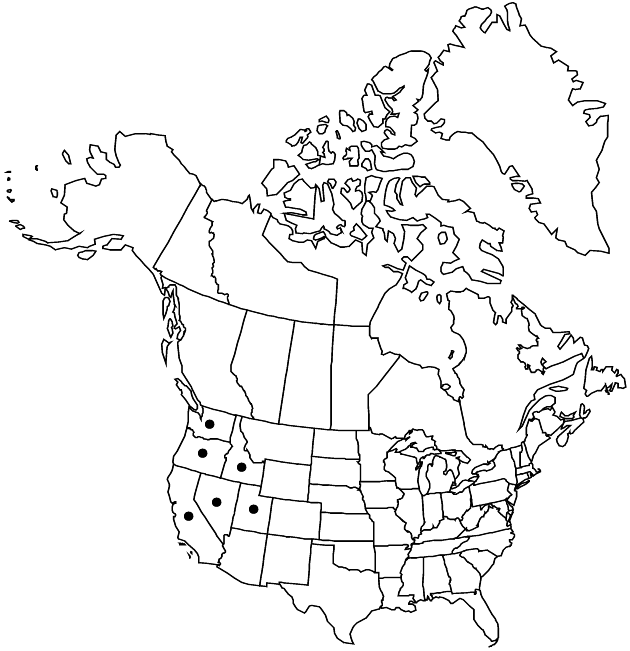Difference between revisions of "Pyrrocoma hirta"
Erythea 2: 69. 1894.
FNA>Volume Importer |
FNA>Volume Importer |
||
| Line 25: | Line 25: | ||
|distribution=w United States. | |distribution=w United States. | ||
|discussion=<p>Varieties 3 (3 in the flora).</p><!-- | |discussion=<p>Varieties 3 (3 in the flora).</p><!-- | ||
| − | --><p>Pyrrocoma hirta is recognized by its relatively short stature, villous, glandular-stipitate stems, lanceolate, coarsely serrate leaves, and loose, racemiform arrays. R. A. Mayes (1976) suggested that it is closely related to P. lanceolata. Much overlap occurs in the characters used to differentiate the varieties.</p> | + | --><p><i>Pyrrocoma hirta</i> is recognized by its relatively short stature, villous, glandular-stipitate stems, lanceolate, coarsely serrate leaves, and loose, racemiform arrays. R. A. Mayes (1976) suggested that it is closely related to <i>P. lanceolata</i>. Much overlap occurs in the characters used to differentiate the varieties.</p> |
|tables= | |tables= | ||
|references= | |references= | ||
| Line 68: | Line 68: | ||
|publication year=1894 | |publication year=1894 | ||
|special status= | |special status= | ||
| − | |source xml=https://jpend@bitbucket.org/aafc-mbb/fna-data-curation.git/src/ | + | |source xml=https://jpend@bitbucket.org/aafc-mbb/fna-data-curation.git/src/8f726806613d60c220dc4493de13607dd3150896/coarse_grained_fna_xml/V19-20-21/V20_958.xml |
|tribe=Asteraceae tribe Astereae | |tribe=Asteraceae tribe Astereae | ||
|genus=Pyrrocoma | |genus=Pyrrocoma | ||
Revision as of 15:28, 18 September 2019
Plants 10–60 cm. Stems 1–4, erect or ascending, reddish, sometimes sparsely leafy, sparsely to densely villous, tomentose, or woolly, usually stipitate-glandular distally. Leaves: basal petiolate, blades lanceolate to oblanceolate or elliptic, 40–200 × 8–45 mm, margins usually coarsely, sharply serrate, sometimes entire, frequently stipitate-glandular, sometimes ciliate, apices acute, faces villous to tomentose, sometimes stipitate-glandular; cauline petiolate, lanceolate, 15–75 × 3–20 mm, becoming sessile and reduced distally, bases clasping. Heads usually 3–7 in loose, racemiform arrays, rarely borne singly (short- or long-pedunculate). Involucres hemispheric to campanulate, 7–12 × 8–20 mm. Peduncles 1–4 cm. Phyllaries in 2–3 series, loose or appressed, green throughout or only distally (bases chartaceous), linear-lanceolate, unequal to subequal, apices acute, faces villous to tomentose, sometimes stipitate-glandular. Ray florets 10–34; corollas 6–15 mm. Disc florets 30–60; corollas 5–7 mm. Cypselae subcylindric, 3–4.5 mm, 3–4-angled, faces striate, sericeous-strigose; pappi whitish to tawny, 5–7 mm.
Distribution

w United States.
Discussion
Varieties 3 (3 in the flora).
Pyrrocoma hirta is recognized by its relatively short stature, villous, glandular-stipitate stems, lanceolate, coarsely serrate leaves, and loose, racemiform arrays. R. A. Mayes (1976) suggested that it is closely related to P. lanceolata. Much overlap occurs in the characters used to differentiate the varieties.
Selected References
None.
Lower Taxa
Key
| 1 | Stems villous or tomentose, ± woolly, sparsely stipitate-glandular; phyllaries appressed, unequal, green only distally | Pyrrocoma hirtavar. lanulosa |
| 1 | Stems glabrate or sparsely villous, densely stipitate-glandular; phyllaries loose, subequal, green throughout | > 2 |
| 2 | Basal leaves 50–200 × 15–45 mm, faces glabrate to sparsely villous; involucres 8–12 × 12–20 mm | Pyrrocoma hirta var. sonchifolia |
| 2 | Basal leaves 40–80(–160) × 10–30 mm, faces densely villous; involucres 7–11 × 8–15 mm | Pyrrocoma hirta var. hirta |